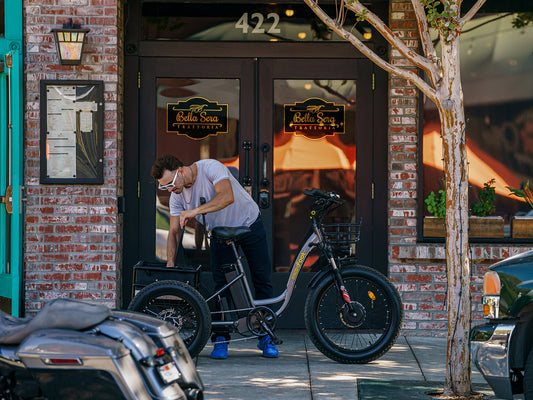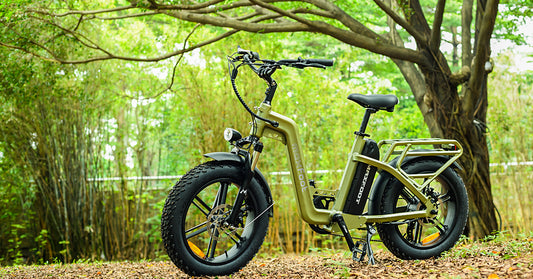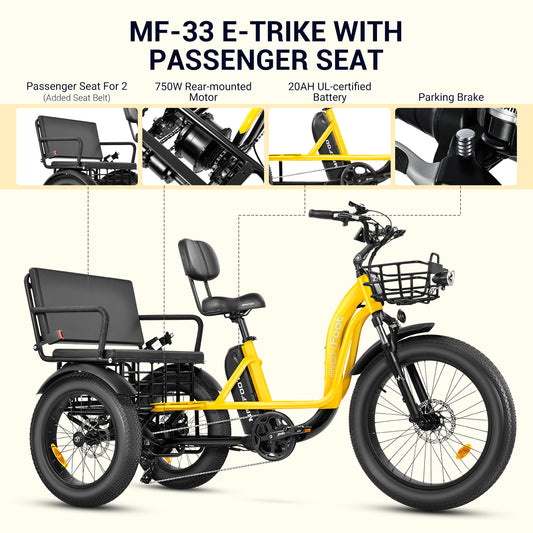While traditional cycling has long been recognized for its cardiovascular benefits and calorie-burning potential, the introduction of ebikes raises an intriguing question: can ebiking aid in weight loss efforts?
Well, ebiking can be an effective way for weight loss when approached with the right mindset and strategy. It combines the benefits of traditional cycling with the ease and accessibility of electric assistance, making it an attractive fitness option for people of varying fitness levels.
Let’s dive into the science, strategies, and benefits of incorporating ebiking into your fitness routine.

Can You Get a Good Workout on an eBike?
Absolutely. Despite common misconceptions, ebikes are not a cheat code for avoiding physical effort. Models like the Maxfoot MF-30 3 wheeler electric trike provide pedal-assist options that allow riders to control the intensity of their workouts.
By adjusting the pedal-assist level, you can engage in light to high-impact physical activity, ensuring a tailored exercise experience. This flexibility makes ebiking accessible to both beginners and seasoned fitness enthusiasts.
The MF-30’s pedal-assist system, with five distinct levels, promotes muscle engagement and cardiovascular endurance. Riders can challenge themselves on inclines or opt for a steady cruise during recovery periods. Its ergonomic design ensures comfort even on longer rides, making consistent workouts easier to achieve.
The Science Behind Ebiking and Weight Loss
Weight loss fundamentally comes down to burning more calories than you consume. Ebiking helps you burn calories by engaging your muscles and cardiovascular system, albeit with less physical strain than traditional cycling.
Studies have shown that riders can burn anywhere from 300 to 500 calories per hour on an e-bike, depending on factors like speed, intensity, and terrain.
- Calories Burned While Ebiking
Ebiking can burn a surprising number of calories. A 150-pound individual can expend approximately 300 calories per hour using pedal assist, depending on the terrain and effort.
On manual pedaling or higher-intensity assist settings, the calorie burns increases significantly. The Maxfoot MF-30 3 wheel electric bike, with its powerful 750W rear motor and fat tires, supports workouts on diverse terrains, from city streets to rugged trails, amplifying the physical effort required and calorie burn.
- Engaging Both Aerobic and Anaerobic Systems
Riding an ebike encourages both aerobic (low-intensity) and anaerobic (high-intensity) exercise. Aerobic activity improves cardiovascular health, while anaerobic bursts, such as accelerating or climbing hills, enhance muscular strength and endurance. With its seven-speed Shimano gear system, the MF-30 enables smooth transitions between these exercise modes.
- Encouraging Consistency Through Enjoyment
Consistency is the cornerstone of any weight loss journey. The Maxfoot MF-30 3 wheeler electric trike’s user-friendly design, including its padded seat and low step-through frame, ensures comfort and reduces barriers to regular use. With its 48V 20AH long-range battery (up to 85 miles on a single charge), riders can explore more, making workouts feel less like a chore and more like an adventure.
The Psychology Behind Why It Works
Research conducted by the University of Colorado has revealed some interesting insights:
- E-bikes enable individuals to incorporate exercise into their daily routine seamlessly, such as by replacing a sedentary commute.
- Pedelecs make physical activity achievable for those who are typically inactive or unfit by lowering the physical demand required to start riding.
- The electric motor assists in challenging terrains or long distances, making cycling less intimidating and more enjoyable. This fosters a positive association with exercise and increases the likelihood of regular participation.
- Riders can adjust the speed and intensity to their comfort level, allowing for personalized workouts that align with individual fitness levels, which helps build a sense of accomplishment.
- Physiological benefits, such as improved blood sugar regulation and aerobic capacity observed in the study, can reinforce the psychological motivation to continue exercising as individuals notice tangible health improvements.

Throttle Use vs. Pedal Assist for Weight Loss
The throttle mode propels the e-bike forward without requiring you to pedal, reducing physical effort and calorie burn. While this feature is convenient, particularly for rest breaks or tackling steep inclines, it limits muscle engagement and cardiovascular benefits.
For those prioritizing weight loss or fitness improvement, relying solely on the throttle may not yield the desired results.
Pedal assist, on the other hand, requires you to actively pedal, engaging your leg muscles and increasing your heart rate. This mode combines the benefits of exercise with the e-bike’s motorized assistance, making it an excellent choice for burning calories and improving stamina.
Different levels of pedal assist allow you to tailor the intensity of your workout based on your fitness level and goals.
While the MF-30 3 wheel electric bike includes a throttle option for convenience, using the pedal-assist feature maximizes the workout benefits. Combining both can be an effective strategy: use the throttle for breaks and pedal assist for active exercise.
How Ebiking Can Aid in Weight Loss
The MF-30 3 wheel electric bike’s step-through frame and stability-oriented design make ebiking feasible for individuals of all fitness levels, including seniors or those recovering from injuries. This inclusivity encourages more people to stay active.
The electric motor support allows riders to cover greater distances without feeling overwhelmed. Longer rides mean more calories burned, and the ability to explore new routes keeps the experience enjoyable and engaging.
Ebikes make cycling less intimidating and more enjoyable by removing common barriers like steep hills or long routes. This increased convenience often motivates users to ride more frequently, building a sustainable routine that aids in weight loss.
Unlike traditional bikes, ebikes lower the intimidation factor associated with cycling. This encourages people who might otherwise avoid biking to engage in regular exercise.
Regular ebiking boosts heart rate, improves blood circulation, and strengthens the cardiovascular system. Over time, these benefits contribute to better endurance and overall health while supporting weight loss efforts.
Tips for Maximizing Weight Loss with Ebiking
Establish achievable milestones to track your progress. For example, start with a target of riding three times per week and gradually increase the frequency or duration. These incremental steps prevent burnout and ensure long-term commitment.
Take advantage of pedal-assist modes to maintain a steady pace on uphill climbs or during long rides, but challenge yourself by reducing reliance on motor assistance on flat terrains.
Alternate between bursts of high-intensity pedaling and more relaxed riding. This technique, known as High-Intensity Interval Training (HIIT), can boost calorie burn and improve fitness levels.
Longer rides at moderate intensity can enhance fat burning, especially when done consistently. Aim for 30–60 minutes of riding at least 3–5 times a week.
Complement your ebiking routine with a balanced, nutrient-dense diet. Reducing caloric intake while maintaining proper nutrition amplifies the effects of exercise, ensuring consistent weight loss.
Use fitness apps or ebike-specific metrics to monitor speed, distance, and calories burned. Regularly reviewing your data helps identify areas for improvement and keeps you motivated to stay on track.
Conclusion
Ebiking offers a sustainable, enjoyable pathway to weight loss, blending fitness with convenience.
The Maxfoot MF-30 3 wheeler electric trike, with its powerful motor, ergonomic design, and long-range battery, is a prime example of how ebikes can transform exercise routines.
By incorporating interval training, setting realistic goals, and embracing the flexibility of pedal-assist systems, riders of all ages and abilities can make significant strides in their weight-loss journeys.




